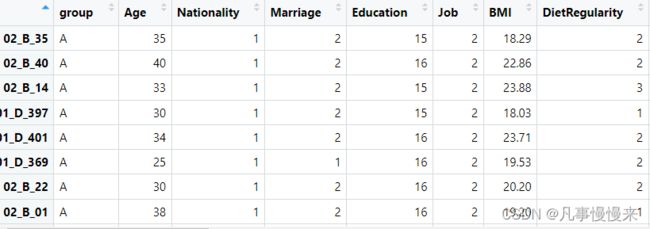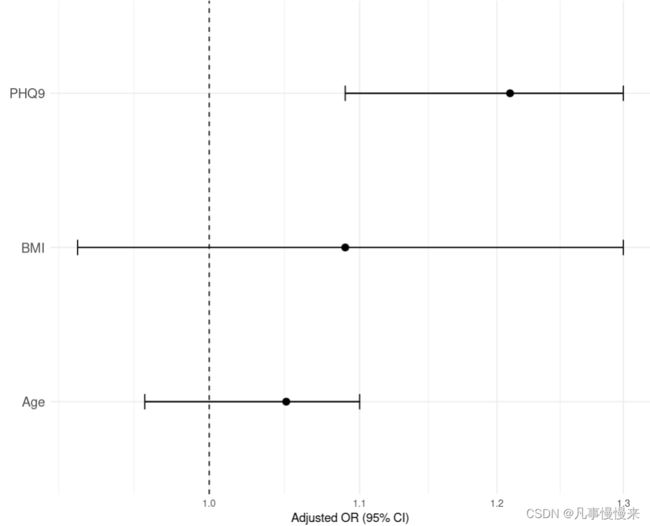R语言进行Logistic回归分析
Logistic回归分析常常用来分析某个结局的危险因素或保护因素。
输入数据格式
分析代码
library(finalfit)
library(rstan)
library(boot)
library(tidyr)
meta$stress = ifelse(meta$IESR > 20, "stress", "health")#获取结局变量,为二分类的
meta$stress = as.factor(meta$stress)
meta$stress = relevel(meta$stress, ref = "health")
explanatory = c("group", "Age", "BMI","PHQ9","DietRegularity")#指定危险因素或保护因素
dependent = 'stress'#指定结局变量
forest_df<- meta %>% #回归分析
finalfit(dependent, explanatory, p=TRUE, column = TRUE) %>%
rename(Univariate = "OR (univariable)")%>%
separate(Univariate, into = c("OR (Univariate)", "p_value_u"), sep = ", TRUE")%>%
separate(p_value_u, into = c("p_value_uni", "x1"), sep = "\\)")%>%
rename(Multivariable = "OR (multivariable)")%>%
separate(Multivariable, into = c("OR (Multivariable)", "p_value_m"), sep = ", TRUE")%>%
separate(p_value_m, into = c("p_value_multi", "x2"), sep = "\\)")%>%
dplyr::select(-x1, -x2)%>%
replace_na(list(p_value_uni = "-", p_value_multi = "-")) %>%
dplyr::select(`Dependent: stress`, `OR (Multivariable)`, p_value_multi)%>%
separate(`OR (Multivariable)`, into = c("Estimate", "lowerlimit", "p"), sep = " ")%>%
dplyr::select(-p)%>%
separate(lowerlimit, into = c("first", "last"), sep = 1)%>%
dplyr::select(-first)%>%
separate(last, into = c("first", "last"), sep = -1)%>%
dplyr::select(-last)%>%
separate(first, into = c("lowerlimit", "upperlimit"), sep = "\\-")%>%
separate(p_value_multi, into = c("first", "p_value"), sep = 1)%>%
dplyr::select(-first)%>%
mutate(sig = ifelse(p_value < 0.05 , "Sig", "Non-Sig"))
forest_df2 <-forest_df %>%
filter(Estimate != "-")%>%
dplyr::rename(Factor = `Dependent: stress`)%>%
arrange(desc(Factor))
forest_df2 = forest_df2[1:3, ]
forest_df2$Estimate <- as.numeric(forest_df2$Estimate)
forest_df2$lowerlimit <- as.numeric(forest_df2$lowerlimit)
forest_df2$upperlimit <- as.numeric(forest_df2$upperlimit)
fig <- ggplot(forest_df2, aes(x=Factor, y=Estimate, ymin=lowerlimit, ymax=upperlimit))+
geom_pointrange(position = position_dodge(width = 0.60))+
geom_hline(yintercept = 1, linetype=2)+
coord_flip()+
xlab('')+
scale_y_log10()+
ylab("Adjusted OR (95% CI)")+
geom_errorbar(aes(ymin = lowerlimit, ymax = upperlimit),width=0.1, position = position_dodge(width = 0.60))+
theme(plot.title = element_text(hjust = 0.5))+
theme_minimal()+
theme(axis.text.y= element_text(size=12))
fig
输出结果
注:PHQ9是抑郁评分,可以看到抑郁是应激的危险因素。

